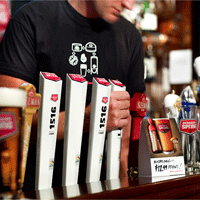This summer was tough on many bar and restaurant owners. The global recession, inconsistent weather (stifling in the west, cold and rainy in the east) and changes to regulations regarding acceptable blood-alcohol limits for drivers in Ontario, led to a decrease in business for many licensees.
When you break down the Ontario beer industry figures from the end of August, some interesting points jump out:
– The industry lost 54,000HL of volume compared to last year, amounting to 5.3 per cent
– Despite the successful launch of Bud Light Lime, packaged beer accounted for 71 per cent of said loss
– The industry sold customers 27,300 fewer kegs this year compared to last
Those figures, while disheartening to operators, tell us people are going out to bars and restaurants less often and they’re drinking less as well; when they do go out, they want to drink something they can’t get at home — draught beer.
Now, more than ever, it’s important that licensees extract as much profit from their draught beer line-up as possible. We know customers will pay a premium for proper draught beer. This is something customers can’t get at home and, when served properly, a great pint is one of life’s simple pleasures.
So, how can you make more margins from your beer line-up? Unfortunately, it’s not as simple as just raising prices. In several markets, draught prices are at their ‘breaking point’ — simply put, if they go any higher, people will stay away and keep drinking at home. But there are other ways to combat this challenge. Here are some steps for extracting maximum profit from your draught beer list:
Know the cost price of every beer you sell (right down to the cost per ounce)
This may seem simple, but how many of you know the price of every brand you stock? Review each brand and ensure your retail price is allowing you to make a sufficient margin. If you know the profit margins you need to make on draught beer, you’ll know which brands are allowing you to hit those targets.
More selection doesn’t guarantee more sales
A standard industry keg (58.6L) has 103 20-oz pints; a 30L keg has 53 20-oz pints. Once a keg is tapped, in order to ensure maximum freshness of that beer, it needs to be sold in a maximum of one week. Bar owners also often stock 14 to 16 brands of beer on tap because they believe their customers want choice. If you take Paerto’s rule — 80 per cent of your sales come from 20 per cent of your brands — that means the other 10 lines are fighting for 20 per cent of sales. Hence, those lines aren’t dispensing fresh beer. Your customers will not pay more money for a bad pint.
Train staff to properly pour draught beer
Draught beer may amount to profits for your business, but how many times have you ordered a pint and seen one of the following?
– The bartender over-pouring the pint, leaving no head for the customer
– The bartender pouring out a quarter-pint of foam and refilling the pint with more beer
– The pints sitting out too long before delivery to customer and needing to be topped up again
All of these scenarios cost money. A properly trained and knowledgeable staff leads to happy customers and repeat business but, more importantly, it also means less waste and more profit. If you can’t train staff yourself, speak to your beer reps to organize a training session for each brand.
Clean lines at least twice a month
Dirty lines are often the cause of bad beer, especially beer that’s foamy or flat. By failing to use a reputable line-cleaning company, like Draught Services, your lines build up dirt and often mould, causing dispensing problems. By investing in regular cleaning, you’ll have fewer dispense problems, less waste, better beer and increased profits.
Differentiate the line-up
Do you really need three light beers on tap? Owners often say, ‘Well, Jimmy only drinks such-and-such light beer’. If Jimmy is not drinking 103 pints a week than Jimmy isn’t drinking fresh beer. Consider stocking that brand in a bottle. Look closely at your draught line-up and the number of lines. Look at those slow sellers — that’s capital you have tied up unnecessarily.
Don’t commoditize the beer line-up
You spend a lot of time trying wines and working with various suppliers, but you don’t list wines in four categories called: white, red, pink and other, so don’t list all your beers as: value, domestic, premium-domestic and import. Maximize the profitable brands by using tiered pricing. It’s not uncommon to have eight to 10 different priced wines on a list — why not do the same with beer? Work with your reps to create more of a distinction between brands with tasting notes, country of origin, style of beer and alcoholic strength.
Use proper glassware and coasters to educate customers
How disappointing to pay a premium for a great pint of Guinness only to have it served to you in another brand’s glass. Your customers remember these things and may not order that second pint. Always ensure each brand is served in a clean, unique glass and handed to the customer with the label facing them. Sometimes the little things go a long way.
Adin Wener is the on-premise channel manager for Sleeman Breweries Ltd. in Ontario.




















